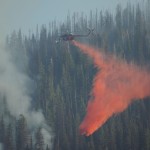Daines, Tester Criticize Forest Service Over Wildfire Funding, Trail Maintenance
Posted: April 19, 2016Source: Flathead Beacon
By: Dillon Tabish
Agency proposing 30 percent reduction in trail funding in Region One over next three years

U.S. Sens. Jon Tester and Steve Daines questioned Forest Service Chief Tom Tidwell last week during a Senate Interior Appropriations Subcommittee hearing focused on the agency’s $4.8 billion budget request for the next fiscal year.
Tester and Daines criticized Tidwell for failing to prioritize trail maintenance in Montana. The agency has revised its formula for funding trail maintenance across the U.S. with an added emphasis on higher population centers. In Region One, which encompasses all of Montana and has 28,000 miles of federally managed trails, the agency plans to reduce appropriations by 30 percent over the next three years. There is an estimated $25 million in deferred trail maintenance in Region One, according to a Forest Service report.
“If we are going to continue to grow our outdoor economy, those trails are pretty damn important,” Tester said to Tidwell.
How the cutbacks will specifically impact local forests such as Flathead National Forest remains to be seen, although current shortages are already emerging. Spotted Bear District Ranger Deb Mucklow told the Missoulian last week that the district needs $250,000 to restore 122 miles of burned-over trails following last year’s massive fire season, but she only has about $80,000 to spend.
The Forest Service is faced with a budgetary conundrum as wildfire costs cripple the agency on an annual basis. Last year the agency depleted its firefighting budget by August amid the costliest fire season in U.S. history. The agency budgeted for $1 billion and the actual costs reached $1.7 billion. It marked the first time the agency spent more than half of its total budget on wildfire suppression. Only 20 years earlier, the agency’s budget devoted only 16 percent on firefighting. This year Congress is giving $1.6 billion to fight wildfires.
Both Tester and Daines have called for reforming the way the nation pays to fight wildfires, treating them like natural disasters that are funded separately instead of leaving the financial burden solely on the Forest Service. Both Tester and Daines have supported a bipartisan bill that surfaced last summer, the Wildfire Disaster Funding Act, that they say would free up money to help the agency better manage the nation’s forests.
“The increased cost of fighting wildfires is having a major impact to outdoor enthusiasts in Montana,” Tester, a sponsor of the bill, said. “If this trend continues it will have permanent consequences to Montana’s outdoor economy, and our western way of life.”
Daines also criticized the agency for failing to address the backlog of forest restoration and management projects under the 2014 Farm Bill, which prioritized nearly 5 million acres of national forest land for treatment due to threats from insects, disease and wildfires. The Farm Bill allowed the Forest Service to identify forest projects that could move forward with timber harvesting and other treatment without the full environmental review process, something that drew blowback from groups that said the agency would be skirting its responsibilities to properly protect resources and wildlife.
To date, roughly 6,200 acres in Montana are in the process of moving forward under the Farm Bill provision.
“Here’s the challenge – we’ve identified in Montana about five million acres with dead or dying trees that increase fire danger – the current implementation schedule is simply not adequate,” Daines said last week.
In an interview with reporters afterward, Daines said the agency is setting aside $10 million to address Farm Bill forestry projects in Montana, which is “a step in the right direction.”
But Daines emphasized his concern that forest projects are still regularly being hampered by “excessive litigation.”
Daines said there are 21 timber projects under active litigation in Region One. Of those projects, 13 were formed through a collaborative process, he said.
“We need to reward and incentivize collaborative developed projects. There are a lot of good examples of collaboration in Montana and we need to encourage that,” he said.
Calling for reforms to the nation’s forest management system, Daines said, “We need to discourage obstructionist litigation.”
Daines also said he remains opposed to transferring federal lands to the state but he later hedged his stance by saying, “I do support a greater voice of Montanans and greater levels of leadership in the management of our public lands from a state level.”
“With the way our national forests are managed, I think Montanans could do a better job,” he added. “Give our governors and states more say and more power in managing our national forests.”
